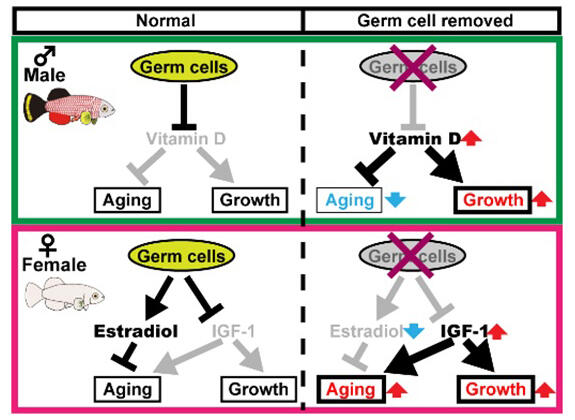A research team led by Professor Tohru Ishitani and Assistant Professor Kota Abe of the Research Institute for Microbial Diseases at Osaka University, in collaboration with researchers of the Osaka University Graduate School of Medicine, Kyushu University's Medical Institute of Bioregulation, and Gunma University's Institute for Molecular and Cellular Regulation has found that germ cell removal in the small fish "African turquoise killifish (Nothobranchius furzeri; hereafter killifish)" extends lifespans in males and shortens them in females. Moreover, the effect of germ cells on activated vitamin D production underlies shortening or extension of the lifespan of the fish. This work was published in Science Advances.

Provided by Osaka University
The mechanism by which the lifespan and aging rate of animals are determined is one of the ultimate mysteries of biology. The long-held hypothesis of the trade-off between reproduction and longevity states that an animal's reproductive capacity and longevity are incompatible, meaning that animals producing more offspring have shorter lifespans, whereas those producing fewer offspring have longer lifespans. Observational studies have supported this hypothesis; however, the reproduction-longevity trade-off has not been fully validated through experiments nor understood mechanistically.
According to a study conducted 25 years ago, simply removing germ cells from the body of C. elegans increases lifespan. Later, similar results were obtained in males and females of Drosophila melanogaster. As a result of this germ cells are considered to reduce lifespan. Meanwhile, in vertebrates including humans, there are data studies showing a longer lifespan in males whose reproductive tissues have been removed (eunuchs); however, this has not been experimentally verified. This is because aging studies using model animals require more time due to their long lifespans.
To resolve this, the research group conducted a study in killifish, which have a lifespan of about 6 months, which is about one-sixth of that of a mouse. Killifish lose weight and pigmentation at an advanced age, and exhibit senescence characteristics similar to humans, such as muscle atrophy and retinal degeneration. First, morpholino antisense oligonucleotides were injected to killifish embryos at a developmental stage of germ cell formation to specifically inhibit the function of dnd (dead end gene), which is required for germ cell formation. With this method, they obtained killifish in which testes and ovaries are present but the ability to produce germ cells is removed. Both males and females in this population increased in body size. While the female's lifespan is approximately 20% longer than that of males in normal killifish, germ cell-depleted that males and females had a similar lifespan. Alternatively, germ cell removal increased the lifespan in males and shortened the lifespan in females.
Analysis of the germ cell-depleted females revealed a marked decrease in estrogen, a female hormone. This experiment also confirmed an increase in lipid synthesis and blood coagulation factors, suggesting that increased risk of vascular disease is, at least partially, responsible for decreased lifespan. Furthermore, insulin/IGF signaling, which is responsible for body growth and regulation was activated, and it was assumed that oxidative stress and other damaging factors shortened lifespan. In males, removal of germ cells did not alter these signals, increased muscle stem cells involved in muscle regeneration, and increased collagen in the skin and bone mass.
Comprehensive gene expression profiling by transcriptome analysis revealed elevated expression of vitamin D-activating enzyme in the livers of germ cell-depleted males. Vitamin D promotes calcium absorption. In this study, increased vitamin D signaling in muscle and skin was also confirmed. These data indicate that male germ cells suppress vitamin D signaling, and activation of the signal by germ cell removal may contribute to lifespan extension in males. Therefore, they kept killifish in water supplemented with active vitamin D and found that the lifespan was extended in both males and females. This is the first study to show that vitamin D administration extends the lifespan in vertebrates.
Ishitani said, "When I was a student, I was very surprised to learn that germ cell removal increased the lifespan of C. elegans. In this study we observed that germ cells influence the lifespan in higher vertebrates like human beings having greatly different body structures and hormonal systems. In future studies, we will collaborate with medical researchers and data scientists to analyze data on activated vitamin D in people who have long healthy lives from existing cohort studies to determine whether vitamin D administration increases the lifespan of humans. On the other hand, by employing the current methodologies we may be able to find new targets for life extension."
Journal Information
Publication: Science Advances
Title: Sex-dependent regulation of vertebrate somatic growth and aging by germ cells
DOI: 10.1126/sciadv.adi1621
This article has been translated by JST with permission from The Science News Ltd. (https://sci-news.co.jp/). Unauthorized reproduction of the article and photographs is prohibited.




